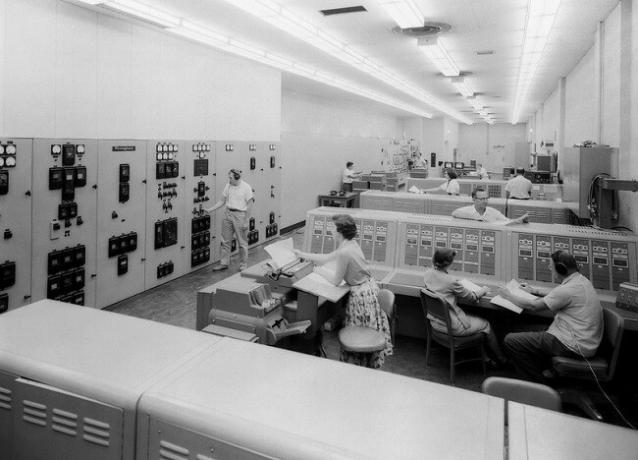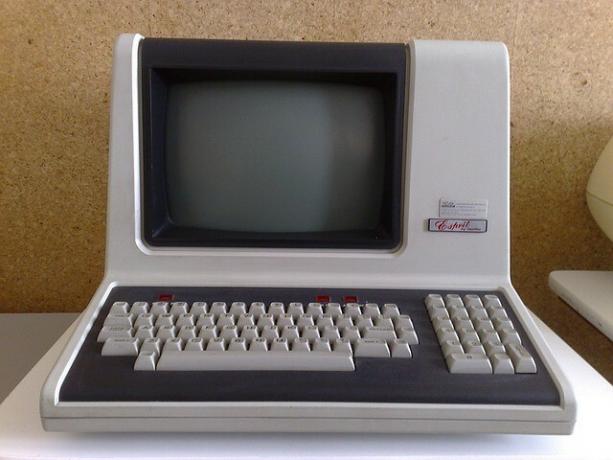Generations of computers: what are they, characteristics and examples
There are five generations of computers, classified according to their components or technology used: vacuum tubes, transistors, integrated circuits, microprocessors, and artificial intelligence.
A generation of computers is a period in which a group of devices with similar technology, characteristics and capabilities are launched on the market, even if they are from different manufacturers. When a device is created that outperforms the rest due to its components or technology, then a new generation begins.
For example, when the first computers with microprocessors emerged, which are the ones we use today, they displaced those that were composed of integrated circuits and that were much larger, heavier and slower. This change meant the arrival of a new generation of computers.
| Period |
Component/ main technology |
Programming language | Characteristics | Examples | |
| First generation | 1940-1956 | Empty tubes | Machine language |
|
Univac |
|---|---|---|---|---|---|
Second generation |
1956-1963 |
Transistors | Assembly language |
|
PDP-1 |
Third generation |
1964-1971 |
Integrated circuits |
|
|
UNIVAC 1108 |
Fourth generation |
1971-present |
Microprocessors |
|
|
|
Fifth generation |
Present-future |
|
|
|
|
First generation: vacuum tubes

Between 1940 and 1956 the first computers appeared that gave rise to the devices that we know today. At that time, they were devices made up of large vacuum tubes that occupied entire rooms.
A vacuum tube is an electronic component in the shape of a bulb, which is responsible for amplifying or modifying an electrical signal. This device was key to the development of telecommunications and computing and in fact, is still used today in devices such as microwave ovens or transmitters radio frequency.
First-generation computers could only perform one operation at a time and consumed a lot of electrical power. They were programmed with machine language, which is a low-level programming language, and the input and output of the data was done with punch cards.
An example of first-generation computers is Univac, developed for the United States Census Bureau in 1951.
See also Computer types
Second generation: transistors

From 1956 to 1963, the second generation of computers that arrived with the invention of transistors remained in force. This marked the replacement of vacuum tubes and an important advance in the world of computing. A transistor is a device that serves as a regulator of electric current, which allowed the creation of more efficient computers in terms of energy.
Second-generation computers were not only differentiated by their technology and smaller size, but by the change in the programming language, which passed to assembly language. This language is basic and not portable, that is, it could not be used on another computer, but it consumes less resources than its predecessor.
These computers continued to use punch cards to enter the data.
An example of a second generation computer It is the PDP-1, a device developed in 1960 for scientific research purposes and where the first video game in history, Spacewar, was played.
Third generation: integrated circuits

From 1964 to 1971 the market was dominated by the third generation of computers, characterized by the incorporation of integrated circuits that replaced transistors. An integrated circuit is a chip made of silicon that has different components that form a kind of miniature circuit.
In this type of computer the input and output data were managed through peripheral devices such as the monitor, keyboard or printer. In addition, the use of operating systems became widespread, which are a type of software that allows the execution of multiple instructions simultaneously.
From this generation on, high-level programming languages began to be used in a massive way, such as COBOL, FORTAN, Pascal, etc. These types of languages differ from low-level languages in that they are much closer to natural language (used by humans) than to machine language (binary code). In addition, they are portable, so they can be used on other devices.
An example of third-generation computers It was the UNIVAC 1108, an update to the first generation UNIVAC created in the 1950s.
See also Software types
Fourth generation: microprocessors

Starting in 1971, computers stopped working with integrated circuits and began to incorporate microprocessors. A microprocessor is an integrated circuit but much more complex, capable of managing all the functions of a computer. That is why it is also known as the Central Processing Unit or CPU.
The fourth generation of computers was characterized by including two types of memory:
- RAM: Stores program data temporarily while the computer is on.
- ROM memory: Stores program data permanently.
These types of computers use high-level programming languages, such as JavaScript, Python, or Java. The input and output of the data is done through peripheral devices such as the keyboard, scanner, monitor, CDs, etc. In addition, its size and the decrease in production costs caused this type of computer to be sold massively.
An example of fourth generation computers it would be the Apple Macintosh and the PCs.
See also Hardware and software
Fifth generation: artificial intelligence, quantum computing and nanotechnology

The fifth generation of computers is made up of all devices already created or in the process of being developed. creation that incorporate technologies such as artificial intelligence, quantum computing or nanotechnology.
Artificial intelligence would allow computers to recognize and learn human language autonomously, without user intervention. The incorporation of quantum technology would allow computers to work with huge amounts of data that are not yet possible to process. While nanotechnology favors the creation of increasingly smaller components with greater storage capacity.
The fifth generation of computers is portable and is characterized by the entry and exit of computers data can not only be done from hardware, but also from voice or recognition facial.
Between 1980 and 1990, the Japanese government tried to develop its own "fifth generation of computers", based on artificial intelligence. However, the project failed.
An example of fifth generation computers they are smartphones, which have greater storage capacity and speed than a fourth generation computer. In addition, they are small in size, have an internet connection and recognize natural language and facial expressions.
See also Advantages and disadvantages of technology


